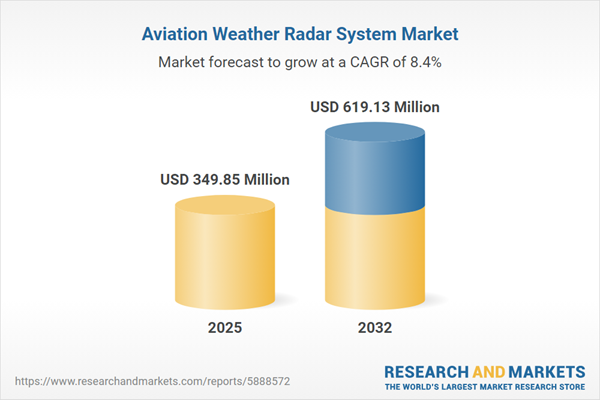Speak directly to the analyst to clarify any post sales queries you may have.
Advanced aviation weather radar systems are transforming how global airlines, regulatory bodies, and technology providers approach flight safety and operational resilience. As demand intensifies for solutions that deliver actionable intelligence, these systems have become essential assets in modern air traffic management.
Market Snapshot: Aviation Weather Radar System Market Size & Growth
The Aviation Weather Radar System Market grew from USD 323.67 million in 2024 to USD 349.85 million in 2025. It is expected to continue growing at a CAGR of 8.44%, reaching USD 619.13 million by 2032.
Scope & Segmentation
This report provides a comprehensive analysis, detailing segmentation by platform, technology, and geography:
- Type: Airborne Radar, Ground Radar
- Component: Antennas, Duplexer, Processors, Reciever, Transmitters
- Radar Range: Long Range, Medium Range, Short Range
- Frequency Band: C Band, X Band
- Distribution Channel: Offline Retail, Online Retail
- Application: Civil Aviation (Cargo Airliners, Commercial Airlines, Private Aircraft), Military Aviation
- Region: Americas (United States, Canada, Mexico, Brazil, Argentina, Chile, Colombia, Peru), Europe, Middle East & Africa (United Kingdom, Germany, France, Russia, Italy, Spain, Netherlands, Sweden, Poland, Switzerland, United Arab Emirates, Saudi Arabia, Qatar, Turkey, Israel, South Africa, Nigeria, Egypt, Kenya), Asia-Pacific (China, India, Japan, Australia, South Korea, Indonesia, Thailand, Malaysia, Singapore, Taiwan)
- Key Players: Aerodata AG, Airbus SE, BAE Systems PLC, Baron Weather Inc., Elbit Systems Ltd., Enterprise Electronics Corporation, EWR Radar Systems Inc., GAMIC GmbH, General Dynamics Corp., Hensoldt AG, Honeywell International Inc., Israel Aerospace Industries Ltd., Kratos Defense & Security Solutions Inc., L3Harris Technologies Inc., Leonardo S.p.A, Lockheed Martin Corporation, Northrop Grumman Corp., Raytheon Technologies Corp., Saab AB, Teledyne FLIR LLC, Terma A/S, Thales Group, The Boeing Company, Toshiba Infrastructure Systems & Solutions Corporation, Vaisala Oyj
Key Takeaways for Decision-Makers
- Continuous advancements in digital signal processing, phased-array antenna technology, and sensor fusion are raising system precision and adaptability in real-time flight scenarios.
- Artificial intelligence and predictive analytics are empowering aviation weather radar operators to shift from reactive monitoring to proactive, risk-mitigating strategies for safer and more efficient routing.
- Hardware miniaturization and improved power management are expanding access to lightweight, energy-efficient modules, enabling adoption across a broader spectrum of commercial and military aviation platforms.
- Strategic regional investments—particularly in the Americas, Europe, Middle East, and rapidly growing Asia-Pacific—are driving system upgrades, infrastructure modernization, and interoperable network deployment to meet rising air traffic needs.
- Open architecture and modular design trends are simplifying system integration, extending lifecycle value, and allowing seamless upgrades to meet evolving operational demands.
Tariff Impact on Radar Supply Chains
Section 232 tariff provisions imposed on imported radar components are reshaping procurement strategies, prompting manufacturers to diversify suppliers and pursue regional partnerships. These measures are causing firms to focus on supply chain resilience, optimize sourcing channels, and negotiate trade compliance to manage operational costs effectively.
Methodology & Data Sources
The report employs a multi-phase approach, combining primary interviews with technical and regulatory experts and a secondary review of peer-reviewed journals, patents, and official documentation. Findings are rigorously validated using triangulation and peer reviews by subject matter specialists to ensure reliability and analytical precision.
Why This Report Matters
- Delivers actionable insights on aviation weather radar innovations and market positioning for informed strategic planning by senior executives.
- Identifies emerging opportunities and risks across platform, component, and regional dimensions to optimize capital allocation decisions.
- Supports procurement, compliance, and partnership strategies in the context of evolving technology standards and global trade policies.
Conclusion
Ongoing digital innovation, regional modernization programs, and supply strategy shifts are altering the landscape for aviation weather radar systems. Organizations optimizing for data-driven, adaptable solutions will be positioned for sustained leadership amid shifting regulatory and operational dynamics.
Additional Product Information:
- Purchase of this report includes 1 year online access with quarterly updates.
- This report can be updated on request. Please contact our Customer Experience team using the Ask a Question widget on our website.
Table of Contents
3. Executive Summary
4. Market Overview
7. Cumulative Impact of Artificial Intelligence 2025
Companies Mentioned
The companies profiled in this Aviation Weather Radar System market report include:- Aerodata AG
- Airbus SE
- BAE Systems PLC
- Baron Weather, Inc.
- Elbit Systems Ltd.
- Enterprise Electronics Corporation
- EWR Radar Systems, Inc.
- GAMIC GmbH
- General Dynamics Corp.
- Hensoldt AG
- Honeywell International Inc.
- Israel Aerospace Industries Ltd.
- Kratos Defense & Security Solutions, Inc.
- L3Harris Technologies Inc.
- Leonardo S.p.A
- Lockheed Martin Corporation
- Northrop Grumman Corp.
- Raytheon Technologies Corp.
- Saab AB
- Teledyne FLIR LLC
- Terma A/S
- Thales Group
- The Boeing Company
- Toshiba Infrastructure Systems & Solutions Corporation
- Vaisala Oyj
Table Information
| Report Attribute | Details |
|---|---|
| No. of Pages | 196 |
| Published | November 2025 |
| Forecast Period | 2025 - 2032 |
| Estimated Market Value ( USD | $ 349.85 Million |
| Forecasted Market Value ( USD | $ 619.13 Million |
| Compound Annual Growth Rate | 8.4% |
| Regions Covered | Global |
| No. of Companies Mentioned | 26 |









